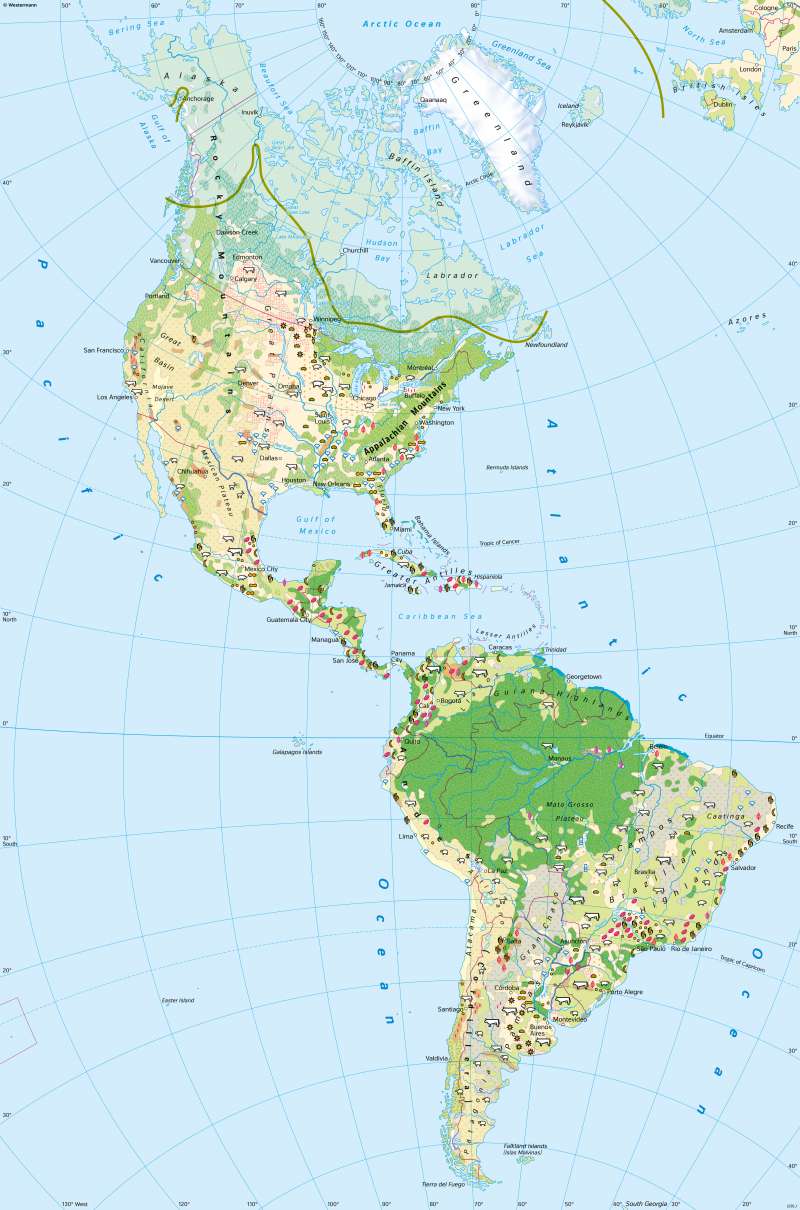The Americas - Land cover and agriculture
Vegetation, agriculture and conservation
978-3-14-100890-6 | Page 174 | Ill. 1

Overview
Large areas of Canada and Alaska cannot be used for agriculture for climatic reasons. Even within the boundaries of cereal growing, large areas are occupied by boreal coniferous forest and are thus primarily subject to forestry use.
North America
In the Mid-Latitudes of North America, the cultivation of sugar beet, maize and wheat is widespread, as is cattle and pig farming. Wheat cultivation is concentrated in the steppe zone (Great Plains); in South America the equivalent is the pampas. In the Midwest of the US, the combination of forage crop cultivation (maize) and livestock farming (cattle and pigs) is clearly visible. Optimal growing areas for sugar beet are found in the Mid-Latitudes with a warm, sunny, not too humid climate. A dry spring is advantageous. In the summer, there are temperatures around 23 to 25 °C and the late summer consist of cool nights, which increase the sugar content. If the annual rainfall is below 500 to 600 millimetres, as in parts of the western USA, irrigation is necessary. The same applies to cotton cultivation there.
In the subtropical areas, especially in California and Florida, citrus fruits are cultivated, in California predominantly also on irrigated land. In the southeast of the USA, on the other hand, cotton, sugar cane, peanuts and tobacco are also grown in the warm, humid climate. Because of the extraordinarily high water demand, rice cultivation is concentrated in the Mississippi Valley and the Gulf Coast.
Central and South America
Agriculture in Central America, the Caribbean and most of South America is characterised by tropical and subtropical fruits such as sugar cane, banana, cotton, coffee, cocoa and rubber. In western South America, sugarcane cultivation is linked to irrigation because of the high water demand (at least 1200 millimetres per year). Because sugar cane, which is sensitive to cold, requires temperatures of 25 to 28 °C that are as constant as possible, its cultivation is restricted to the tropics and parts of the subtropics. In the temperate climate of South America, wheat is cultivated on a large scale. Viticulture is mainly found in Mediterranean climates (Chile, as well as in California). Cattle farming in South America is predominantly found in the area of wet savannas, while sheep and goats are mostly kept on steppe or high mountain grasslands.
Infrastructure and world market
The technologically well-developed agriculture of the USA, Brazil and Argentina is strongly export-oriented. Its share of production is high for some world trade goods, such as soybeans or green coffee. In some Central American countries, on the other hand, it is more traditionally structured and primarily oriented towards the domestic market.
In some countries, specialisation in individual export products and the resulting dependence on the world market has become a problem. The latter was demonstrated by the example of Cuba, which for decades earned more than three quarters of its export revenues from the sale of sugar. After the collapse of the Soviet Union as the most important trading partner, Cuba's economy fell into a severe crisis. Another example is provided by the former "banana republics".
Central and South America
Agriculture in Central America, the Caribbean and most of South America is characterised by tropical and subtropical fruits such as sugar cane, banana, cotton, coffee, cocoa and rubber. In western South America, sugarcane cultivation is linked to irrigation because of the high water demand (at least 1200 millimetres per year). Because sugar cane, which is sensitive to cold, requires temperatures of 25 to 28 °C that are as constant as possible, its cultivation is restricted to the tropics and parts of the subtropics. In the temperate climate of South America, wheat is cultivated on a large scale. Viticulture is mainly found in Mediterranean climates (Chile, as well as in California). Cattle farming in South America is predominantly found in the area of wet savannas, while sheep and goats are mostly kept on steppe or high mountain grasslands.




